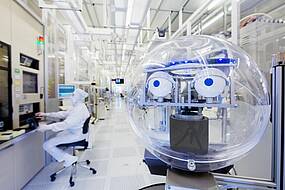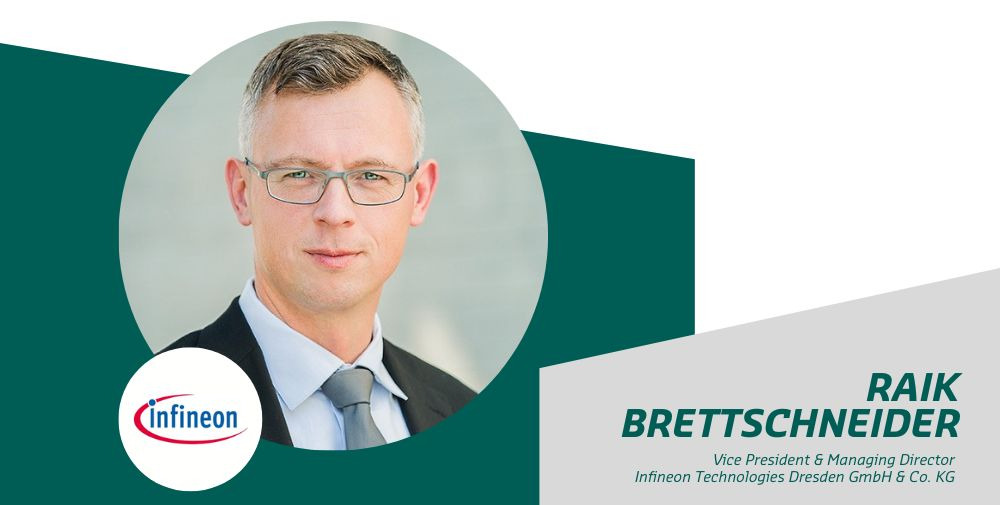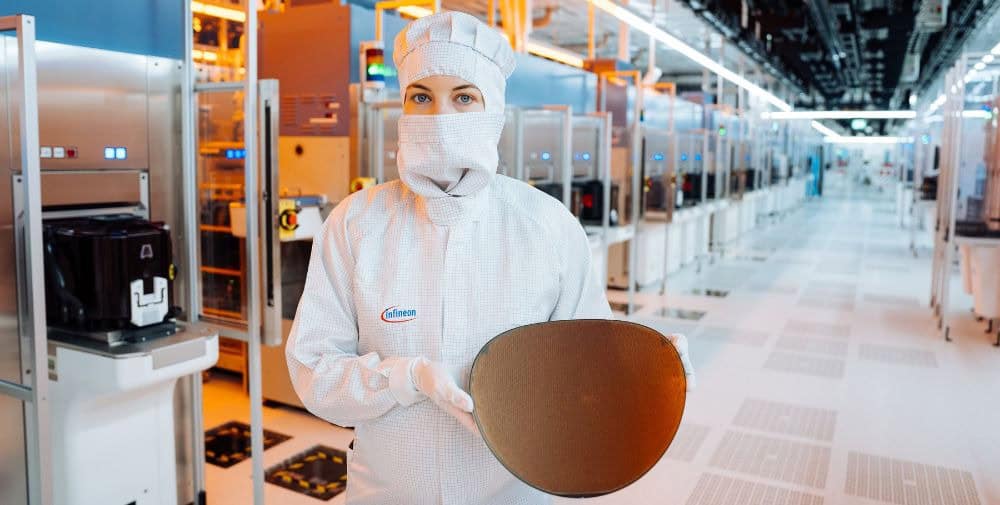But before that, let’s take a brief look at Infineon Dresden.
- Date of opening: 1994
- Number of production sites worldwide: 25
- Size of plant (area): 300,000 m² (expansion planned for 2026)
- Size of clean room(s): 40,000 m²
- Size of wafers: 200 mm / 300 mm
- Application industries: Automotive, industrial electronics / consumer
- Number of employees: 3,200 (+ 1,000 planned for 2026)
- Number of nationalities: 47
- Proportion of women: 25 %
- Skilled workers sought: maintenance technicians


© Infineon Technologies Dresden GmbH & Co. KG
Mr. Brettschneider, what is the importance of the Dresden site for the group?
Dresden is one of Infineon’s largest and most important development and production sites, covering central parts of the semiconductor value chain: technology development, product development and front-end manufacturing. The strategic importance of the Dresden site is underlined by the close technical connection with the site in Villach, Austria. Both sites operate high-volume production of power semiconductors on 300mm thin wafers.
In what specific areas has investment been made since the site opened, and how high was this investment in total?
In the past 12 years, Infineon has invested around Euro 1.7 billion in the Dresden site, in particular in the expansion of manufacturing capacity.
For what uses does the Dresden site produce? What exactly can the chips produced do and in which sectors/industries are they used?
Infineon Dresden produces power semiconductors, sensors and microcontrollers for all four of the group’s business areas: automotive, industrial power control, power & sensor systems, connected secure systems.
There are now several fabs, numerous supplier companies and research institutions, as well as microelectronics-related software companies in Saxony. In which areas is the network particularly important for your company?
Infineon Dresden works closely with local universities and research institutes in the development of innovative manufacturing technologies and new products.
The topic of skilled workers is not only of concern to us. Currently, Saxony’s ICT sector is growing by about 5,000 skilled workers per year, which equates to more than 100,000 skilled workers in 2030 if growth remains constant. What role does direct proximity to other fabs play in the context of your skilled workforce strategy? Does it tend to make the location more attractive or the competition greater?
In recent years, the economic region of Saxony has become larger and thus more attractive. We find this development very pleasing and we expect that the importance of Dresden as a location will continue to increase. However, the increasing shortage of skilled workers will become the most important challenge for the further growth of the local microelectronics industry in the coming years.
At the location, almost all semiconductor manufacturers are expanding their capacities, in addition to global players such as TSMC and Intel. What impact does this have for you in terms of supply chains, service providers, raw materials and also skilled workers?
We welcome the planned settlement of Intel in Magdeburg. This will move the chip industry even further into the public consciousness. We do not currently anticipate any direct impact on the supply of raw materials or the supply of skilled workers in the Silicon Saxony region.
What is your vision for the location? How (preferably with concrete examples) should it be further developed?
Infineon Dresden will continue to be one of Infineon’s largest and most important development and production sites in the future, forming a leading production network for power electronics together with the Villach site.
What are concrete support measures that are necessary on the way to this vision? Key words: support programs, education sector, skilled labor strategies, measures at state or federal level, etc.
We are pleased that politicians have increasingly understood in recent years that microelectronics is a key industry for Germany and Europe. The trends of decarbonization and digitalization present society with enormous tasks that we will only solve with innovative semiconductors. If we want to keep these technologies in Europe, we need support at all levels of government – through attractive framework conditions for investment. This includes not only funding programs, but also an environment that attracts skilled workers from other regions. Only in this way can the European microelectronics industry survive in global competition.
Thank you very much for the interview, Mr. Brettschneider.
This interview was first published as part of our magazine NEXT “In Focus: Microelectronics”. All other interviews of the Saxon semiconductor plants can be found in the complete edition.
👉 Go to the full issue of the magazine





